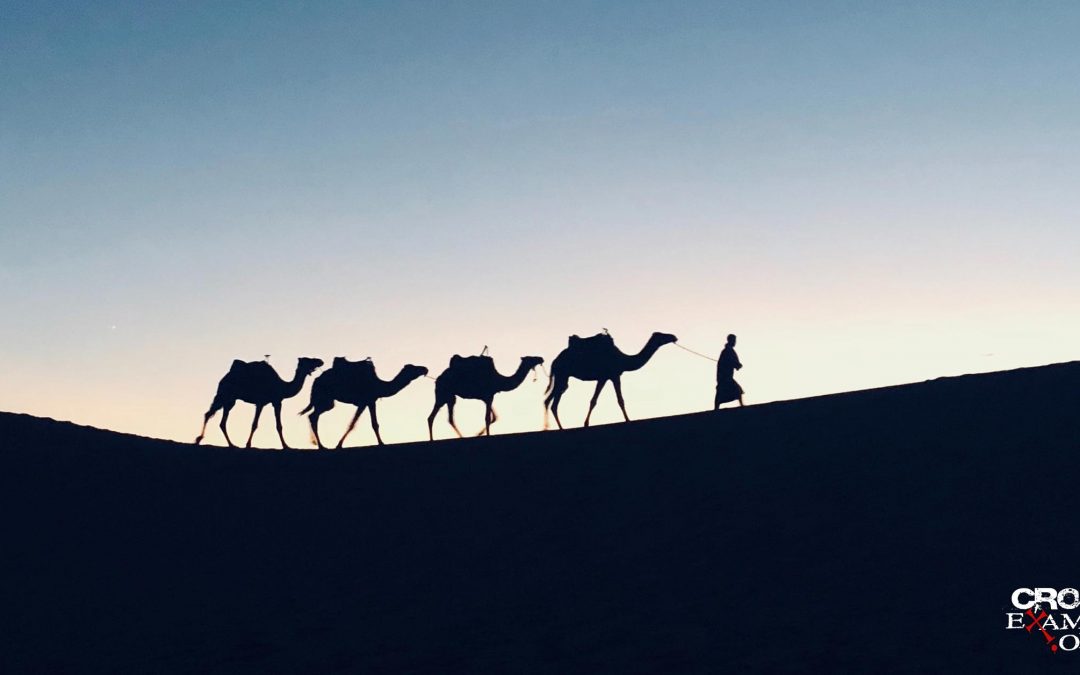Camels in the Bible?
Engaging skeptical challenges to the Old Testament and Camels in the Bible
Most people I knew growing up had no problem saying most Old Testament stories were based on some kind of real event. Even those who were skeptical about supernatural parts of the Scriptures didn’t question basic details of ordinary events like Abraham’s travels or even the presence of camels in the Bible.
Today, not so much. Many archaeologists and historians are challenging the reliability of biblical stories in the public square. From college classrooms to YouTube, many people get their views on the Bible from books, articles, and documentaries that try hard to undermine the truth of Scripture. This is probably why even the ordinary details of Old Testament narratives can raise questions in people’s minds. For example, could Abraham really have used camels?
Could Abraham really have used camels?
Skeptics say the camels in the Bible show up at the wrong time and in the wrong place. Many are quick to allege there’s no evidence of camels in the Middle East until about a thousand years after Abraham. In a 2014 New York Times article called “Camels Had No Business in Genesis,” John Noble Wilford wrote:
Camels probably had little or no role in the lives of such early Jewish patriarchs as Abraham, Jacob and Joseph, who lived in the first half of the second millennium B.C., and yet stories about them mention these domesticated pack animals more than 20 times… The archaeologists, Erez Ben-Yosef and Lidar Sapir-Hen, used radiocarbon dating to pinpoint the earliest known domesticated camels in Israel to the last third of the 10th century B.C. — centuries after the patriarchs lived.[1]
There are two kinds of camels
It’s true there are camels in the Bible. Genesis says Abraham brought camels back to Canaan from his time in Egypt (12:16) and his servant brought camels from Canaan to Aram (24:10-11). Did the Bible get this wrong? Gordon Johnson teaches in the Old Testament department at Dallas Theological Seminary. He talks about camels in the Bible and explains what the archaeologists really found and why counting the humps on camels can help us think through this issue:
When [Ben-Yosef and Sapir-Hen] were excavating, they found camel bones [belonging to a camel with one hump [2] But there are two types of camels: One-hump camels and two-hump camels. The first time one-hump camels appear in Israel is about 1,000 B.C. So the Internet blogs went crazy: “These Israeli archaeologists proved the Bible’s wrong—camels didn’t exist in Israel until about 1,000 B.C.” And that’s true for one-hump camels. but this is important: One-hump camels were late; two-hump camels were early.
Here’s what he means by “late” and “early”: There probably weren’t many camels with just one hump in Israel until a “late” date, after Abraham’s time. But the rest of the story is we know ancient drawings and texts show camels with two humps were already in Egypt at an “early” date, way before Abraham. Turns out, knowing the difference between one-hump camels and two-hump camels can help us respond to skeptics who insist the Bible got this all wrong.
Keep this in mind when you see camels in the Bible: The fact is two-hump camels were in Egypt about 12,000 B.C. and they were all over the Ancient Near East by 7,000 B.C. They were domesticated by about 3,000 B.C. That’s 1,000 years before Abraham.
Evidence for Camels in Ancient Egypt
When skeptics raise questions about camels in the Bible, they often miss the difference between camels with one hump those with two. One-hump camels were for trade. Two-hump camels were for travel and that’s exactly what Abraham was using his camels for. He got them in Egypt where they’d already been for thousands of years.
Ancient texts around that time from Nippur[3], Ugarit[4], and Alalakh[5], mention two-hump camels. There are even rock carvings and drawings of these kinds of camels 1,000 years before Abraham. For example, This cylinder seal from Abraham’s time shows a circle with two figures riding on each hump of a two-hump camel[6]. Archaeologists also discovered a rock drawing from Egypt from 200 years before Abraham showing a domesticated one-hump camel being led by an Egyptian[7].
Abraham Used Camels for Travel
Sometimes, archeological discoveries can raise questions about certain details of ancient stories, like the presence of camels in the Bible. But it’s important to get the whole story. Even if one-hump camels weren’t all over Israel during Abraham’s time, archaeology has shown us it’s not unlikely that Abraham got two-hump camels for his travels in Egypt, where they had already existed for thousands of years. Camels in the Bible are no problem at all.
Notes
[1] John Noble Wilford, “Camels Had No Business In Genesis,” The New York Times, February 10, 2014, Sec. Science, Https://Www.Nytimes.Com/2014/02/11/Science/Camels-Had-No-Business-In-Genesis.Html. This Idea Was Not New. Albright Asserted This Popular View Amongst Mainstream Scholars: “It Was Only In The 11th Century Bc That Camel-Riding Nomads First Appear In Our Documentary Sources … Any Mention Of Camels In The Period Of Abraham Is A Blatant Anachronism.” William F. Albright, Archaeology And The Religion Of Israel (Johns Hopkins, 1968), 96.
[2] Lidar Sapir-Hen And Erez Ben-Yosef, “The Introduction Of Domestic Camels To The Southern Levant: Evidence From The Aravah Valley,” Tel Aviv 40 (2013): 277–85.
[3] A Sumerian Text Alludes To The Milk Of Bactarian Camels, Implying Domestication. See Gleason Archer, “Old Testament History And Recent Archaeology From Abraham To Moses,” Bibliotheca Sacra 127, No. 505 (1970): 17.
[4] A Sumerian Text Mentions Bactarian Camels In A List Of Domesticated Animals. T.M. Kennedy, “The Date Of Camel Domestication In The Ancient Near East,” Http://Www.Biblearchaeology.Org/Post/2014/02/17/The-Date-Of-Camel-Domestication-In-The-Ancient-Near-East.Aspx.
[5] A Fodder List Mentions A Bactarian Camel. Archer, “Old Testament History And Recent Archaeology From Abraham To Moses,” 17.
[6] See The Artifact: “Cylinder Seal With A Two-Humped Camel Carrying A Divine Couple,” The Walters Art Museum · Works Of Art, Accessed September 7, 2017, Http://Art.Thewalters.Org/Detail/27381/Cylinder-Seal-With-A-Two-Humped-Camel-Carrying-A-Divine-Couple/.
[7] See The Artifact: Donald Redford And Susan Redford, “Graffiti And Petroglyphs Old And New From The Eastern Desert,” Journal Of The American Research Center In Egypt 26, No. 27 (1989) Figure 42: 3–49.
Recommended resources related to the topic:
Counter Culture Christian: Is the Bible True? by Frank Turek (DVD)
Mikel Del Rosario helps Christians explain their faith with courage and compassion. He is a doctoral student in the New Testament department at Dallas Theological Seminary. Mikel teaches Christian Apologetics and World Religion at William Jessup University. He is the author of Accessible Apologetics and has published over 20 journal articles on apologetics and cultural engagement with his mentor, Dr. Darrell Bock. Mikel holds an M.A. in Christian Apologetics with highest honors from Biola University and a Master of Theology (Th.M) from Dallas Theological Seminary where he serves as Cultural Engagement Manager at the Hendricks Center and a host of the Table Podcast. Visit his Web site at ApologeticsGuy.com.
Original Blog Source: https://bit.ly/3gJFBLn



















Facebook Comments